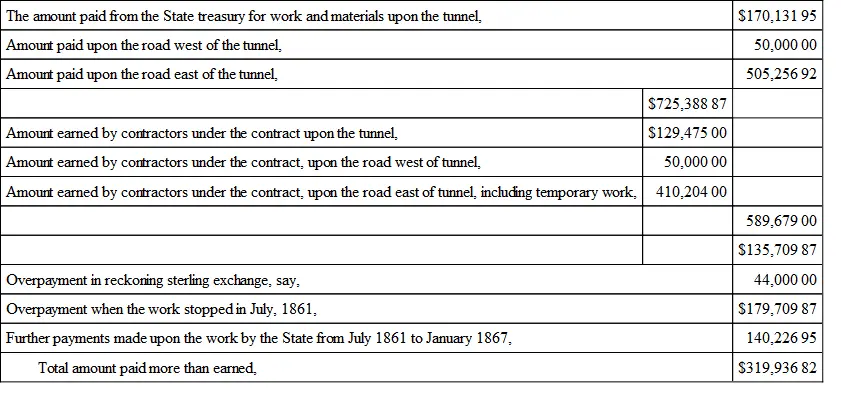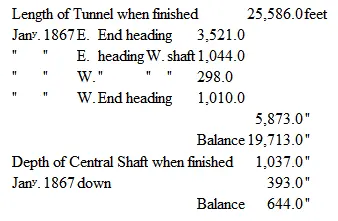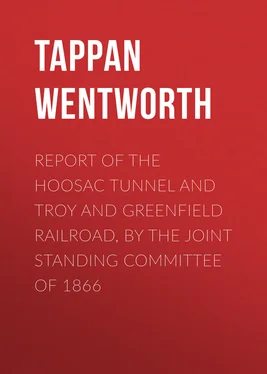Tappan Wentworth - Report of the Hoosac Tunnel and Troy and Greenfield Railroad, by the Joint Standing Committee of 1866
Здесь есть возможность читать онлайн «Tappan Wentworth - Report of the Hoosac Tunnel and Troy and Greenfield Railroad, by the Joint Standing Committee of 1866» — ознакомительный отрывок электронной книги совершенно бесплатно, а после прочтения отрывка купить полную версию. В некоторых случаях можно слушать аудио, скачать через торрент в формате fb2 и присутствует краткое содержание. Жанр: foreign_antique, Технические науки, foreign_edu, на английском языке. Описание произведения, (предисловие) а так же отзывы посетителей доступны на портале библиотеки ЛибКат.
- Название:Report of the Hoosac Tunnel and Troy and Greenfield Railroad, by the Joint Standing Committee of 1866
- Автор:
- Жанр:
- Год:неизвестен
- ISBN:нет данных
- Рейтинг книги:5 / 5. Голосов: 1
-
Избранное:Добавить в избранное
- Отзывы:
-
Ваша оценка:
- 100
- 1
- 2
- 3
- 4
- 5
Report of the Hoosac Tunnel and Troy and Greenfield Railroad, by the Joint Standing Committee of 1866: краткое содержание, описание и аннотация
Предлагаем к чтению аннотацию, описание, краткое содержание или предисловие (зависит от того, что написал сам автор книги «Report of the Hoosac Tunnel and Troy and Greenfield Railroad, by the Joint Standing Committee of 1866»). Если вы не нашли необходимую информацию о книге — напишите в комментариях, мы постараемся отыскать её.
Report of the Hoosac Tunnel and Troy and Greenfield Railroad, by the Joint Standing Committee of 1866 — читать онлайн ознакомительный отрывок
Ниже представлен текст книги, разбитый по страницам. Система сохранения места последней прочитанной страницы, позволяет с удобством читать онлайн бесплатно книгу «Report of the Hoosac Tunnel and Troy and Greenfield Railroad, by the Joint Standing Committee of 1866», без необходимости каждый раз заново искать на чём Вы остановились. Поставьте закладку, и сможете в любой момент перейти на страницу, на которой закончили чтение.
Интервал:
Закладка:
In February, 1858, the contract was again changed, and Messrs. Haupt and Cartwright engaged with the corporation to complete the road and tunnel. At this time, the records show that no payments had been made under the previous contracts "for more than two years; that the work could only be carried on by the continued efforts, increased expenditures, and personal credit of the contractors."
By a provision of this contract, any revenue arising from the use of the road, or any portion of it, was assigned to the contractors until their claims upon the company were adjusted; and the payment of all the company's debts was to be deferred until that of the contractors was satisfied; and Haupt & Co. agreed to maintain the organization of the corporation, pay its bills for printing, and advance therefore a sum not less than $500,000.
The same year the Rensselaer Iron Company was allowed a lien on the iron delivered to the contractors until the same was paid for. In 1859, H. Haupt relinquished his pecuniary interest in the contract, and was appointed chief engineer of the corporation. (See Appendix A, page 62.) These transactions in which the contractors participated, (one of whom was on the board of directors,) show conclusively that they were fully apprized of the condition of the corporation, from the date of their first connection with the work to the time of its "suspension," no claim during the whole period having been made by them against the Commonwealth for any work done for the corporation.
The existence of the mortgages to the State were of course well known to the contractors. They were given in pursuance of laws passed by the legislature, and for security of the payments received by the contractors for their services. The right of the Commonwealth to take possession of the railroad under the mortgages, must have been well understood. Further, the corporation, in surrendering the road to the State, did no injury to the contractors, for the act of surrender did not take place until after the contractors had suspended work upon both road and tunnel, and practically abandoned the enterprise; thus leaving to the State the alternative, either to take possession of the work and complete the road and tunnel, or to abandon it; and, in addition to the loss of the advances already made, forego the anticipated benefits of an additional avenue for Western traffic.
The treasurer's books do not show any settlement between Haupt and Company and the corporation. The account standing upon the ledger shows a large balance against the contractors; but the Committee are informed that subsequent to May 30, 1863, a settlement was made upon the basis of Mr. Stevenson's report (see Appendix A,) and that Mr. Haupt received, in conformity with the contract of H. Haupt & Co. with the Troy and Greenfield corporation, payment for all labor done and material furnished by said H. Haupt & Co., for the corporation, and that all matters between the parties have been adjusted.
Although the accounts between the contractors and the corporation are understood to be settled, it may be interesting to examine the account of the Commonwealth with the enterprise and compare the value of the work done by the contractors at the time of its abandonment by them, with the payments made to them therefore, from the treasury of the State.

From the foregoing statement it appears that the contractors with the Troy and Greenfield Railroad corporation, have received from the State, three hundred and nineteen thousand nine hundred and thirty-six dollars and eighty-two cents more than the value of the work which the corporation surrendered under the mortgage, and that the State has lost that amount of money in its efforts to assist in the construction of the work. It is proper to add as the judgment of the very intelligent chairman of the commissioners (Mr. J. W. Brooks,) from whose statement to the Committee the foregoing figures are taken, that the loss to the State in the transaction by the failure of Messrs. B. Haupt & Co., to perform their contract in a proper manner, will reach the sum of three hundred and fifty thousand dollars. (See statement, Appendix C.)
The Commonwealth having taken possession of the road and tunnel, and by the legislation of 1862 and 1863 undertaken their construction with the free consent of the corporation, the directors by an appropriate vote, expressed their concurrence with the proceeding, and their reliance upon the "good faith of the legislature" to complete the enterprise which had exhausted the resources of its immediate projectors. The last act of the corporation, as appears by the records, was the choice of officers in August, 1865, when Alvah Crocker was chosen president and Wendell T. Davis, clerk and treasurer.
Description of the Tunnel.
The tunnel enters the eastern side of the Hoosac Mountain, in the town of Florida, a few rods from the right bank of the Deerfield River. The eastern summit of the mountain is 2,210 feet above tide-water, 1,499 feet above the Deerfield River, 1,429 feet above the grade of the railroad, and is distant from the East Portal of the tunnel 6,100 feet. The western summit is 2,510 feet above tide-water 1,788 feet above the Hoosac River, 1,718 feet above the grade of the railroad, and 6,700 feet distant from the West Portal. Each portal of the tunnel is 766 feet above tide-water. The summits are 2 41/ 100miles distant from each other, and the valley between them at its lowest depression is 801 feet above the grade of the railroad.
The length of the tunnel, from the East End to the West End, as commenced by Mr. Haupt, is 4 84/ 100miles. Its base is, at the East End, 70 feet above the Deerfield River, and at the West End, 70 feet above the Hoosac River. Its grade, from the East End to the Central Shaft, is 18 feet per mile; from the West End to West Shaft, 26 4/ 10feet per mile; and from the West Shaft towards the Central Shaft, 21 12/ 100feet per mile. These grades are calculated to allow the free passage of water from the centre. Should the quantity of water found in the tunnel render feasible a reduction of this grade, a change is contemplated.
Transcription of text
Profile of Hoosac Mountain

The dimensions of the tunnel areas follows: The rock cutting is 24 feet high and 24 feet wide. The brick-work is 26 feet high and 26 feet wide. The bottom of the tunnel will contain a culvert three feet deep at the centre. Through this culvert the water from the tunnel is to be discharged. It now receives, in addition to the water accumulating in the tunnel, a 12-inch pipe, to carry air at a low pressure for ventilation; an 8-inch pipe to carry air for driving the drilling machines; and a 3-inch pipe for carrying water for use in the holes which are being drilled. Should it be found advisable to use gas in carrying on the work, provision is made for a 4-inch pipe to carry the gas from the place of manufacture. The track is to be placed 3 1/ 2feet above the bottom of the rock tunnel, and 4 1/ 2feet above the bottom, where lined with brick.
The distance by the highway, from the town of North Adams, or from the West End to the East End of the tunnel, is about nine miles. From the first named points to the Central Shaft is about five miles, and from the Central Shaft to the East End the distance is six miles.
The time necessary to travel from the West End to the East End, is two hours. Loaded teams from either end to the other perform the distance and return in a day.
Organization of the forces employed in the construction of the Hoosac Tunnel, June, 1866.
Читать дальшеИнтервал:
Закладка:
Похожие книги на «Report of the Hoosac Tunnel and Troy and Greenfield Railroad, by the Joint Standing Committee of 1866»
Представляем Вашему вниманию похожие книги на «Report of the Hoosac Tunnel and Troy and Greenfield Railroad, by the Joint Standing Committee of 1866» списком для выбора. Мы отобрали схожую по названию и смыслу литературу в надежде предоставить читателям больше вариантов отыскать новые, интересные, ещё непрочитанные произведения.
Обсуждение, отзывы о книге «Report of the Hoosac Tunnel and Troy and Greenfield Railroad, by the Joint Standing Committee of 1866» и просто собственные мнения читателей. Оставьте ваши комментарии, напишите, что Вы думаете о произведении, его смысле или главных героях. Укажите что конкретно понравилось, а что нет, и почему Вы так считаете.












